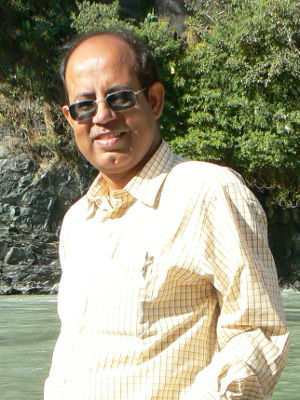
Shyamal Kumar Chattopadhyay
Professor
Department of Chemistry
Academic Qualifications
- B.Sc.:Chemistry Honours from St. Xavier’s College, Kolkata (Under University of Calcutta)
- M.Sc.: Chemistry with Inorganic Chemistry special paper, from University of Calcutta
- Ph.D.: Chemistry (1988); Indian Association for the Cultivation of Science, Jadavpur, Calcutta- 700 032 (Jadvpur University)
Thesis title: “Chemistry of Ruthenium ligated to some hard-soft donors”
Awards and Honors
- Selected for UGC NET, in 1986 and CSIR NET scholarship in 1983 and 1986.
- Worked as a Brain Pool visiting scientist at the Advanced Materials Division of Korea Research Institute of Chemical Technology, South Korea for the period December 2006 – November 2007.
Membership of Professional Societies
Life Members of
- Indian Chemical Society
- Chemical Research Society of India
- Indian Association for the Cultivation of Science
Member Editorial Board: International Journal of Chemistry
Contact
Phone
- Office: +91 033 2668 0521 (Ext. 500)
- Mobile: +91 98743 39079
Address
- Office: Department of Chemistry, Indian Institute of Engineering Science and Technology, Shibpur, Howrah 711 103, India
- Residence: B/171, IIEST Shibpur Campus, P.O. B. Garden, Howrah- 711 103
- EMail: shyamal@chem.iiests.ac.in, shyamalchattopadhyay@gmail.com
Area of Research
Broad Research area: Coordination and Bioinorganic Chemistry
Current research activity:
- a) Chemistry of Ruthenium complexes:
One abiding interest of our group is the study of the Chemistry of Ruthenium complexes, particularly their electrochemical, photophysical and photochemical properties, electronic structures of the complexes, and their applications as sensors and as light absorbing Dye for solar photo-electrochemical cells. - b) Bio-inorganic Chemistry:
In the domain of Bioinorganic Chemistry, our modest aim is to synthesize model complexes of the active sites of some metalloenzymes to understand the spectroscopic properties and the chemical reactivities of the active sites and development of new and efficient homogeneous catalysts by taking leads from the active sites of the metalloenzymes i.e. biomimetic catalysis. More specifically we focus in the following areas:- Chemistry of manganese with reference to factors affecting relative stabilities of different oxidation states, mononuclear and binuclear manganese compounds as model complexes for biological systems, and study of their redox, magnetic properties and electronic structure and their applications as oxidation catalysts.
- Bio-inspired coordination chemistry of vanadium, copper, iron, zinc and the applications of such complexes in homogeneous catalysis.
- (iii) Metal complex-DNA interactions.
Number of Ph. D. thesis guided: 07
Courses Undertaken
M.Sc. (Chemistry) students:
- Theory:
- Bioinorganic chemistry I (1st semester)
- Magnetochemistry I (2nd semester)
- Bioinorganic chemistry II (3rd semester)
- Magnetochemistry II (3rd semester)
- Inorganic Photochemistry(4th Semseter)
- Lab:
- M.Sc., Inorganic chemistry lab for 1st, 2nd and 3rd semester
- No. of M.Sc. projects completed: 27
B.E./ B.Tech. & M.Tech 5-year Dual degree courses:
- Theory (1st and 2nd Semester):
- Bioinorganic chemistry
- Chemical Bonding
- Crystal Field Theory and its applications
- Infrared spectroscopy
- Lab (Sessional): 1st and 2nd Semester
Recent Publications
- B. Ghosh, P. Adak, S. Naskar, B. Pakhira, P. Mitra, S. K. Chattopadhyay, Polyhedron, 131, 74-85 (2017).
- P. Adak, B. Ghosh, B. Pakhira, R. Sekiya, R. Kuroda, S. K. Chattopadhyay, Polyhedron, 127, 135-145 (2017).
- B. Ghosh, P. Adak, S. Naskar, B. Pakhira, P. Mitra, R. Dinda, S. K. Chattopadhyay, Inorg. Chim. Acta, 459, 1-14(2017).
- S. Sagar, S. Sengupta, A. J. Mota, S. K. Chattopadhyay, A. E. Ferao, E. Riviere, W. Lewis, S. Naskar, Cubane-like tetranuclear Cu(II) complexes bearing a Cu4O4 core: crystal structure, magnetic properties, DFT calculations and phenoxazinone synthase like activity, Dalton Trans., 46 , 1249-1259(2017).
- P. Adak, B. Ghosh, A. Bauzá, A. Frontera, A. J. Blake, M. Corbella, C. Das Mukhopadhyay, S. K. Chattopadhyay, Catecholase activity, DNA binding and Cytotoxicity studies of a Cu(II) complex of a pyridoxal Schiff base: Synthesis, X-ray crystal structure, spectroscopic, electrochemical and theoretical studies, RSC Adv., 6, 86851-86861 (2016).
- P. Adak, C. Das, B. Ghosh, S. Mondal, B. Pakhira, E. Sinn, A. J. Blake, A. E. O’Connor, S. K. Chattopadhyay, Two pseudohalide-bridged Cu(II) complexes bearing the anthracene moiety: Synthesis, crystal structures and catecholase-like activity, Polyhedron, 119,39-48(2016).
- S. Mondal, B. Pakhira, A. J. Blake, M. G. B. Drew, S. K. Chattopadhyay, Co(III) and Ni(II) complexes of an anthracene appended aroyl hydrazone: synthesis, crystal structures, DNA binding and catecholase activity, Polyhedron, 117,327-337(2016).
- J. Adhikary, A. Chakraborty, S. Dasgupta, S. K. Chattopadhyay, R. Kruszynski, A.Trzesowska-Kruszynska, S. Stepanović, M. Gruden-Pavlović, M. Swart, D. Das, Unique mononuclear MnII complexes of an end-off compartmental Schiff base ligand: experimental and theoretical studies on their bio-relevant catalytic promiscuity, Dalton Trans. 45, 12409-12422 (2016). 9
- R. Sanyal, X. Zhang, P. Chakraborty, S. Giri, S. K. Chattopadhyay, C. Zhao, D. Das, Role of solvent in the phosphatase activity of a dinuclear nickel(II) complex of a Schiff base ligand: mechanistic interpretation by DFT studies, New J. Chem., 40, 7388-7398 (2016).
- R. Sanyal, P. Kundu, E. Rychagova, G. Zhigulin, S. Ketkov, B. Ghosh, S. K. Chattopadhyay, E. Zangrando, D. Das, Catecholase activity of Mannich-based dinuclear CuII complexes with theoretical modeling: new insight into the solvent role in the catalytic cycle New J. Chem., 40, 6623-6635 (2016).
Book Chapters
- S. K. Chattopadhyay, Ruthenium thiosemicarbazone complexes in Ruthenium: Properties, Production and Applications, D. B. Watson (ed) Nova Science Publishers, Inc., New York, pp293-310(2011) ISBN: 978-1-61761-550-4.
